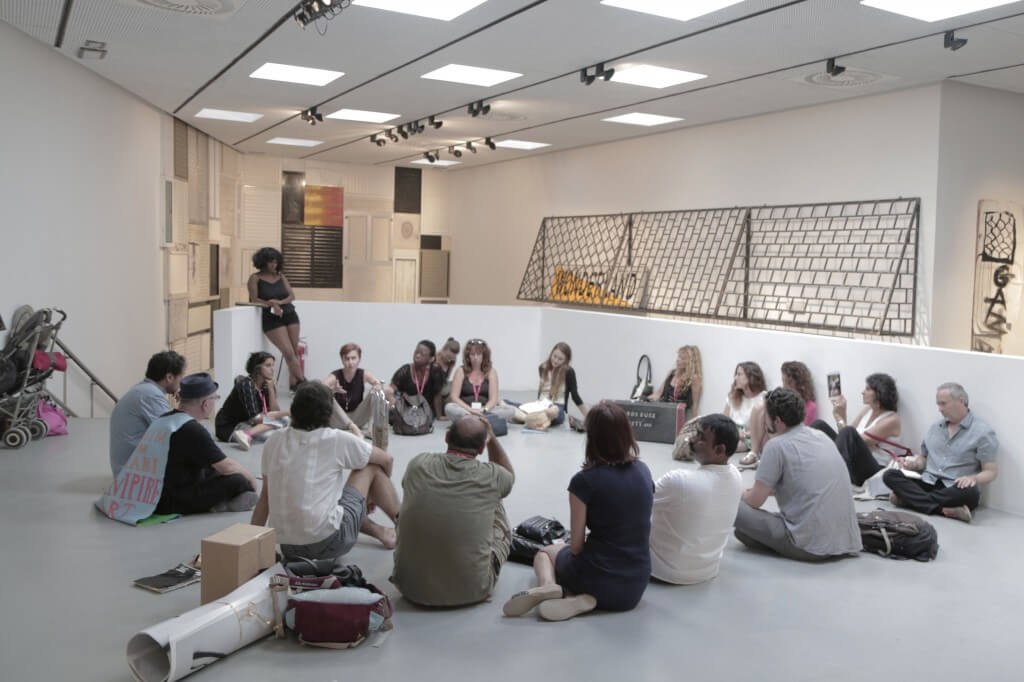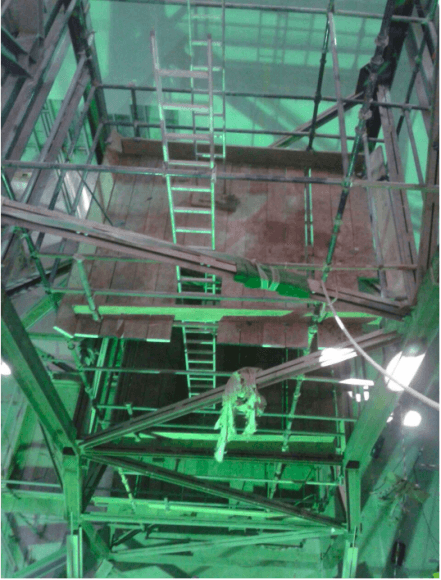Gulf Labor Coalition (GLC) creatively interjected Palestinian resistance and BDS into the 56th International Contemporary Art Exhibition 2015 Venice Biennale, in Venice Italy on Sunday. GLC’s exhibition artists in residence, G.U.L.F. (Gulf Ultra Luxury Faction), staged an intervention performance (video here) adding a stencil of Handala to their exhibition banner hung prominently in the Pavilion Arsenale exhibition hall, read a ‘Statement on Palestine’ and occupied the 2nd floor of the Israeli Pavilion at the exhibit, with visitors in tow.

GLC, an official participant of 2015 Venice Biennale, is a coalition of artists including many prominent international artists, dedicated to the protection of worker’s rights, specifically spreading awareness of abhorrent labor conditions of exploited, heavily indebted migrant workers building a cultural district on Abu Dhabi’s Saadiyat Island off the coast of United Arab Emirates. Slated to become a sophisticated international cultural tourist destination for the wealthy, Saadiyat Island is still under development and will feature branches of iconic world class museums and cultural institutions, including the Louvre Abu Dhabi, Guggenheim Abu Dhabi (12 times the size of New York’s Guggenheim museum), Zayed National Museum and New York University Abu Dhabi.

The significance of Handala as spelled out on GLC’s website; “Handala is an iconic symbol of Palestinian Resistance created in the seventies by Naji al-Ali while he lived as a stateless migrant in the Gulf; it takes on profound dimensions on this banner. As a universal symbol of solidarity, it speaks for the indifference of both the UAE authorities and museums like the Guggenheim and the Louvre, and universities like NYU in taking action on the issues of the migrant workers building the Saadiyat island. The image of Handala: the ten year old boy who turned his back to a world that will not bring the occupation of his homeland to justice also brings Palestine into the picture; workers made stateless on their own land, compelled to cross checkpoints and work on building Israeli Settlements, homes and military establishments.”
Indeed, in Naji al-Ali ‘s own words, “At first he was a Palestinian child, but his consciousness developed to have a national then a global and human horizon.”
Reading a ‘Statement on Palestine’ during one of their actions, G.U.L.F. artists (who had just returned from Palestine) explained “We were struck by the overlap between the circumstances of Palestinian workers and the predicament of South Asian migrants in the Gulf. Under the Occupation, the Palestinian people have become migrant workers in their own land”.
G.U.L.F. then called for a public meeting at the Israeli Pavilion, Israel’s permanent national pavilion at the Biennale, which they occupied for an hour discussing BDS and and PACBI, the Palestinian Campaign for the Academic and Cultural Boycott of Israel, and its “relationship with the art world”.

The complete text of G.U.L.F.’s ‘Statement on Palestine’
An intervention at the Biennale: G.U.L.F and Gulf Labor at Venice:
Political art is everywhere we look at this year’s Biennale, and the warm embrace of Africa and its diasporic struggles is a welcome corrective to decades of neglect. But Palestine does not appear significantly on anyone’s radar, nor is there is any evidence of the solidarity that has carried the BDS movement into many corners of the academic and cultural world. Earlier today, G.U.L.F. (Global Ultra Luxury Faction) began its response to this situation by altering the Gulf Labor Coalition banner hanging in the Arsenale. In this statement, we explain our action.
Before coming to Venice, some of us shot a film about the challenges of daily life in the West Bank. We were struck by the overlap between the circumstances of Palestinian workers and the predicament of South Asian migrants in the Gulf. Under the Occupation, the Palestinian people have become migrant workers in their own land. Many suffer the same indignities and extreme precarity when they cross the notorious Israeli checkpoints to seek work. Behind the Green Line, they are pit against heavily indebted Chinese migrants. Within the West Bank, more and more are compelled to take jobs in Israeli settlement farms and factories on land stolen from Palestinians. Countless others must emigrate from economically ravaged villages and towns to seek a livelihood overseas. Indeed, before South Asians became a preferred workforce, Palestinians were a primary source of migrant labor for the Gulf states.
Those who resist the Occupation are met with harsh forms of detention and worse, though the reality is that most Palestinians feel they are living in a prison. While filming at one village where resistance has become a way of life, we shared the villagers’ experience of being teargassed, strafed by rubber bullets, and hosed with the infamous “skunkwater.” We came to the Biennale with the foul stench of this Odortech chemical on our clothing and in our hair–it can linger for weeks. Compared to the daily stigma endured under the Occupation, ours is a small hardship, just as the UAE’s entry ban on Gulf Labor members is a minor privation when placed alongside the ordeal faced by the Saadiyat workforce. But, as artists and writers, who bear these as the legacies of state repression, we refuse the complacency that serves autocrats in both of these countries.
Scholars have taken the lead in responding to the call by PACBI (Palestinian Campaign for the Academic and Cultural Boycott of Israel) to boycott Israeli institutions, and other sectors (governments, communities of faith, trade unions, and organs of commerce) are joining in. The boycott is now spreading to the general population in countries all over the world. Yet, with some notable exceptions, the institutional artworld has held back.
Following the repudiation, by artist and curators, of Israeli state funding at last year’s Biennale de São Paulo, we feel compelled to bring the BDS spirit to Venice Biennale, where the stateless are obscured by the radiance cast by the national pavilions.
We invite you to join us as we proceed to the Israeli pavilion, where we will hold a community meeting to decide on next steps. Sharing our experiences and opinions will help us understand how and why BDS places direct obligations on artists and cultural institutions like the Biennale.

HIGH CULTURE/HARD LABOR
Gulf Labor Coalition’s book The Gulf: High Culture/Hard Labor, published by OR Books was launched at the Biennale’s Central Pavilion last week.
The book is a collection of contextualized essays and artwork that trace how Gulf Labor has evolved, featuring contributions by an impressive array of esteemed artists and writers.
The 2015 Gulf Labor Field Report is available here (pdf)

Photo: Gulf Labor/ Gulf Labor Report 2015
Thanks to Ofer Neiman



“Under the Occupation, the Palestinian people have become migrant workers in their own land.”
Simple and profound. Everybody should be able to grasp this~ I’m going to start using it to educate the masses around me.
Thanks very much for this article, Annie. It’s awesome.
“G.U.L.F. then called for a public meeting at the Israeli Pavilion, Israel’s permanent national pavilion at the Biennale, which they occupied for an hour discussing BDS and and PACBI, the Palestinian Campaign for the Academic and Cultural Boycott of Israel, and its “relationship with the art world”.”
Thank you, G.U.L.F. & Gulf Labor Artist Coalition! Thanks for the right and overdue kind of “Occupation”. May others follow in your footsteps.
Thanks, Annie–very smart!
Not entirely O/T, and about BDS. What the heck?
From Josh Ruebner:
“Congress holds hearing on Palestinian-led movement, without Palestinians
Imagine if Congress held its first-ever hearing in the 1980s on the impact of boycott, divestment and sanctions campaigns against the apartheid regime of South Africa and failed to call a single witness who supported them. Would anyone take seriously such a blatantly biased hearing as an accurate indication of the principles, aims and successes of this movement?
Yet this is exactly what the National Security Subcommittee of the House Oversight and Government Reform Committee did last week when it convened a hearing to investigate the impact of the Palestinian civil society-led campaign for boycott, divestment and sanctions (BDS) against Israel and corporations and institutions which profit from and/or defend Israel’s oppression of Palestinians. …
…Rep. Ron DeSantis (R-Fla.), chair of the subcommittee (who repeatedly referred to the Israeli-occupied Palestinian West Bank by the pro-settler term “Judea and Samaria”) easily could have called a representative of the Palestinian BDS National Committee, a body that coordinates BDS campaigns with activists around the globe, to testify about the movement’s impact. He could have called the president of the American Studies Association to testify why it voted to boycott Israeli academic institutions. He could have added to the witness list the president of the United Church of Christ, which voted overwhelmingly this summer to divest from U.S. corporations such as Caterpillar, Motorola and Hewlett-Packard to protest their profiteering from Israeli military occupation, becoming the third major Protestant denomination to take similar action after the Presbyterian Church (USA) and the United Methodist Church.
Instead, however, DeSantis called three witnesses hostile to the BDS movement, including the CEO of SodaStream International, Daniel Birnbaum, whose company’s main manufacturing plant is located on expropriated Palestinian land in a West Bank settlement, making it a primary corporate target of the BDS movement. Birnbaum, who passed out settlement product gift bags to fellow witnesses and congressional staff before the hearing, decried flash mob protests and other creative direct actions against his company as “violent.” Another witness, Mark Dubowitz, executive director of the Foundation for Defense of Democracies, repeatedly referred to BDS as “warfare” against Israel, while neglecting to condemn Israel’s actual warfare against Palestinians which inspires the BDS movement.
Rep. Stephen Lynch (D-Mass.), ranking member of the subcommittee, attempted to have a semblance of balance at the hearing by inviting Matthew Duss of the Foundation for Middle East Peace to testify. Duss tepidly endorsed boycotts of Israeli settlement products but distanced himself from the broader campaigns and goals of the BDS movement.
The assumptions and composition of this hearing were problematic for at least three reasons. First, by placing this nonviolent, civil society movement under the scrutiny of a subcommittee ostensibly devoted to investigating matters of national security, the hearing attempted to stigmatize this movement and its practitioners as a threat.
Second, members of Congress and witnesses repeatedly asserted at the hearing that the BDS movement is solely about the “delegitimization” of Israel, rather than about changing its illegitimate practices and policies toward the Palestinians as the BDS call clearly articulates. This overheated argument attempts to exceptionalize Israel, making its conduct immune from the same sort of campaigns that have rectified other historical injustices. Similar nonviolent campaigns utilizing the force of economic pressure have succeeded in ending British colonization and domination in countries from Ireland to India. Closer to home, such tactics were employed successfully by the civil rights movement and the movement for farmworkers’ rights. Why make a sacred cow out of Israel and presume that its behavior should be held to different standards?
Third, by denying Palestinians (or any other supporters of the Palestinian BDS call) a voice at the hearing, Congress is stripping agency from Palestinians and dehumanizing them. By only allowing others to speak about what is arguably the most broad-based, effective Palestinian-led campaign ever to advance their long-denied rights, Congress continues to literally shut Palestinians out from telling their story and articulating their goals and aspirations.
Congress has failed the American public by denying them an opportunity for a balanced and nuanced hearing on the impact of the BDS movement. The House Oversight and Government Reform Committee should remedy this situation by holding a follow-up hearing with witnesses who support the BDS call as a way to achieve Palestinian rights and a just and lasting peace.”
http://thehill.com/blogs/pundits-blog/international/250173-congress-holds-hearing-on-palestinian-led-movement-without#.VcIQjBap1ks.twitter
Not exactly ot, but here is Jon Snow showing the art he recently smuggled out of Gaza (I think the exhibition is Gaza on Gaza? – far frm London, not sure):
http://www.youtube.com/watch?v=UkuCsdAFx9w